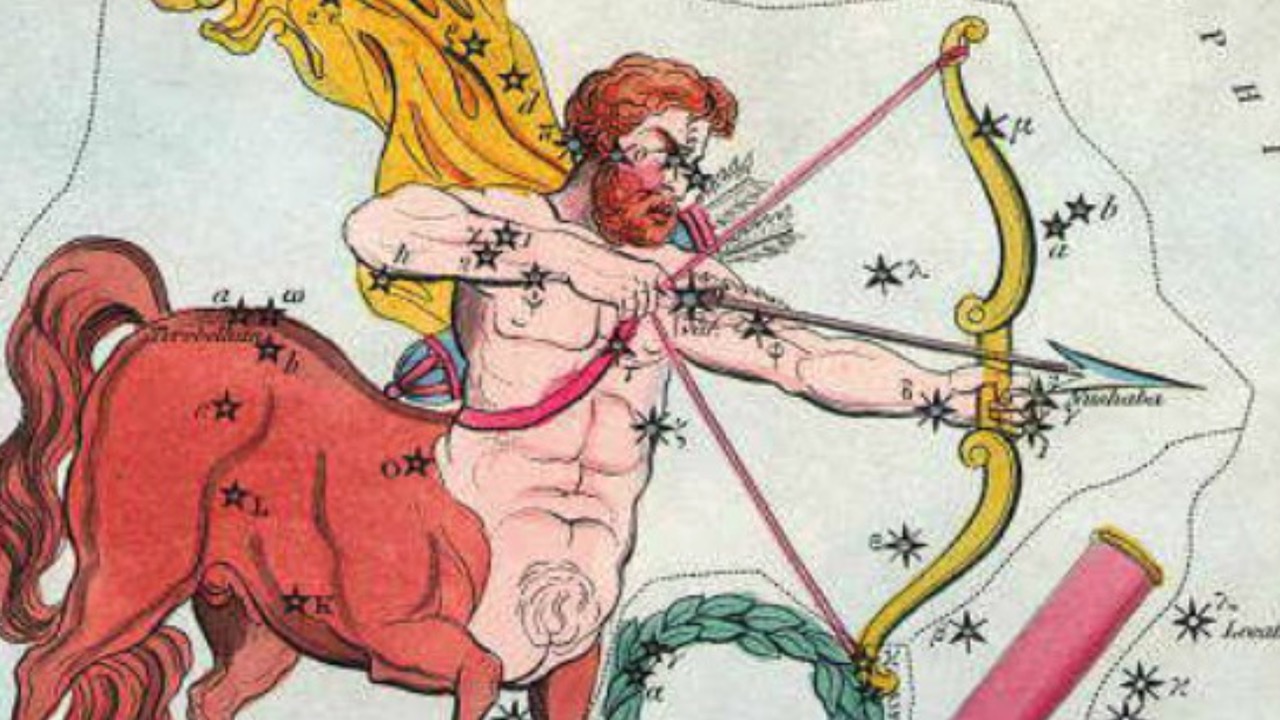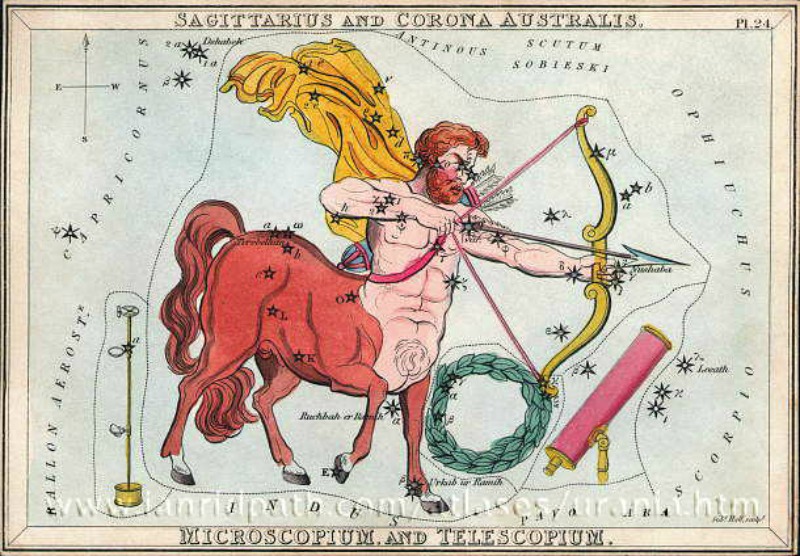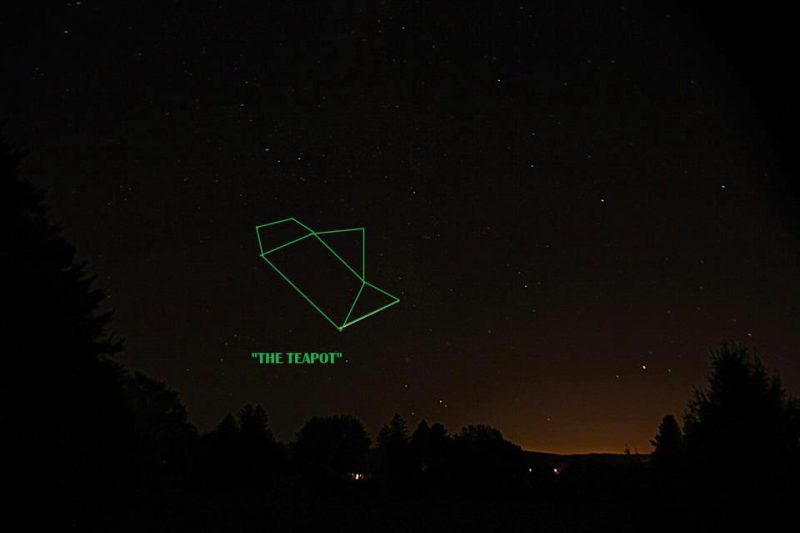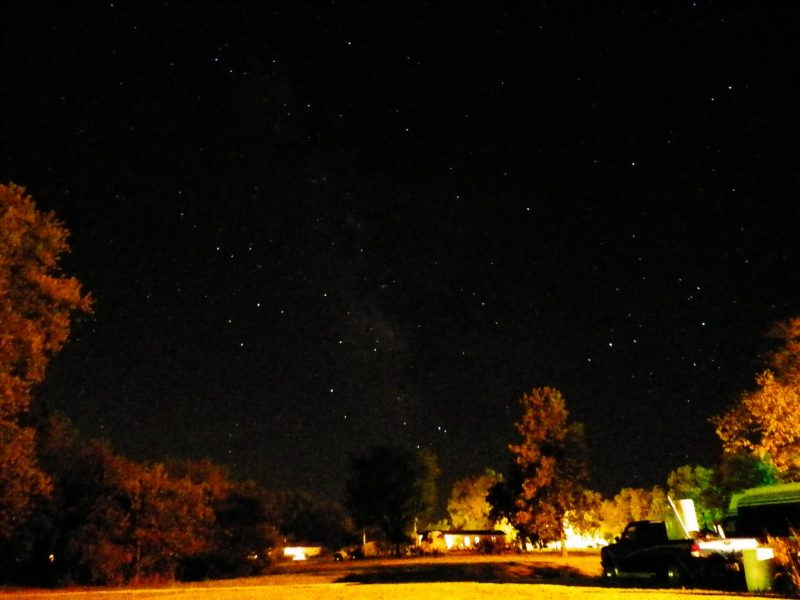

Image via Galactic.name.
If you’re outside on an August or September evening, you can glimpse the zodiacal constellation Sagittarius the Archer. From our northerly latitudes, it never climbs high in the sky. Yet Sagittarius marks the direction in our sky to one of the most wondrous places we can imagine: the center of our own Milky Way galaxy. And the constellation is fairly easy to spot, because its brightest stars form a distinctive shape of a Teapot. Follow the links below to learn how to see Sagittarius, and about the lore and science of this constellation.
How to see the constellation Sagittarius
What’s the difference between the constellation Sagittarius and the sign?
Deep-sky wonders in Sagittarius

The Teapot asterism in the constellation Sagittarius. This image is from Eileen Claffey. She captured it in mid-September 2012. At that time of year, Sagittarius is headed toward the sunset glare.
How to see the constellation Sagittarius. If you want to see Sagittarius, you’ll want first to find a dark location.
In August or September, if you go someplace really dark, and simply look up in the evening, you’ll see the starlit band of the Milky Way. It’ll appear as a hazy band stretching all the way across the sky. The haze is really countless stars. From the Northern Hemisphere, the starlit trail of the Milky Way seems to bulge just before it reaches the southern horizon. You can see this bulge in the night sky, and it marks the approximate location of the Milky Way’s center, which is located within the boundaries of the constellation Sagittarius.
Here’s another way to find Sagittarius. If you’re familiar with the Summer Triangle asterism, draw an imaginary line from the star Deneb and through the star Altair to locate Sagittarius near the horizon. At mid-northern latitudes, the Summer Triangle hangs high in the south to overhead on late summer and autumn evenings.

See the Teapot of Sagittarius in this photo? The center of the galaxy is located in this direction. Image via Lewistown StormWatcher.
What’s the difference between the constellation Sagittarius and the sign? In our modern times, the sun passes in front of the constellation Sagittarius from about December 18 to January 20. These dates are off by about a month from what you read on the horoscope page. The sun moves through the sign Sagittarius from about November 21 to December 21.
Yes, there is a difference between an astronomical constellation and an astrological sign! Keep in mind that we’re talking about the constellation Sagittarius in this article. The horoscope is referring to the sign Sagittarius.
By definition, the sun enters the sign Sagittarius whenever the sun is precisely 30 degrees west of the December solstice point. Then, on the December solstice, the sun enters the sign Capricorn.
While the signs remain fixed relative to the solstices and equinoxes, the solstices and equinox points move 30 degrees westward in front of the constellations – or backdrop stars – in about 2,160 years.
The constellation boundaries were formally defined by the International Astronomical Union (IAU) in 1930. Based on the present IAU boundaries, the December solstice point moved into the constellation Sagittarius in the year -130 (131 B.C.) and will move into the constellation Ophiuchus in 2269 (2269 A.D.).

The constellation Sagittarius, with the Teapot asterism outlined in green. Click here for a larger chart .
Deep-sky wonders in Sagittarius. Sagittarius points to the heart of the Milky Way galaxy. We can’t see all the way to the galactic center because the plethora of stars, star clusters and nebulae between us and the Milky Way center veil it from view.
But trying viewing these deep-sky treasures in Sagittarius with binoculars or a telescope: Sagittarius Star Cloud (Messier 24), globular cluster Messier 22, Lagoon Nebula (Messier 8), Trifid Nebula (Messier 20) and Omega Nebula (Messier 17). Sharp-eyed people can even see these deep-sky objects with the unaided eye. (The above sky chart locates these sites for you.)
Modern stargazers have difficulty making out the Centaur that this constellation is supposed to depict. Most people have an easier time seeing the Teapot asterism in the western half of Sagittarius. Once you learn the Teapot, it’ll greatly assist you on your star-hopping adventures to deep-sky marvels.

A centaur. Image via Wikimedia Commons.
Sagittarius in mythology, and more. The constellations Sagittarius and Centaurus are both supposed to represent a centaur – a creature with the upper torso of a man and the body and legs of a horse. Historically, centaurs might have really been cowboys, using horses to round up cattle in ancient Greece.
According to Greek myth, the centaurs were the offspring of Ixion and the cloud nymph Nephele. Apparently, Sagittarius’ drawn-out bow and arrow originated from the Mesopotamian archer god, and this constellation might not have always represented the centaur Chiron.
It’s said that the Greeks associated Sagittarius with Crotus the satyr – another type of part man, part horse and part goat monstrosity. Quite possibly, the Romans first identified the constellation Sagittarius with Chiron, the wise and kindly centaur.
Here’s something that distinguishes Sagittarius the Archer from the other 13 constellations of the zodiac. The sun shines in front of this constellation on the December 21 solstice.
Also, the ecliptic – the sun’s yearly pathway in front of the backdrop stars – intersects the galactic equator in Sagittarius. Although the sun crosses the galactic equator twice a year every year, much ado was made about the alignment of the December solstice sun with the galactic equator in 2012. Actually, if we are to accept the galactic coordinates as defined by the IAU in 1959, the solstice points were in alignment with the galactic equator in 1998. By 2012, the time had long passed.

If you spot Sagittarius, don’t forget to look nearby for neighboring Scorpius. Image via Matthew Chin in Hong Kong.
Enjoying EarthSky? Sign up for our free daily newsletter today!
Bottom line: Look for the constellation Sagittarius on an August or September evening. The brightest stars in Sagittarius form the distinctive shape of a teapot.
Taurus? Here’s your constellation
Gemini? Here’s your constellation
Cancer? Here’s your constellation
Leo? Here’s your constellation
Virgo? Here’s your constellation
Libra? Here’s your constellation
Scorpius? Here’s your contellation
Sagittarius? Here’s your constellation
Capricornus? Here’s your constellation
Aquarius? Here’s your constellation
Pisces? Here’s your constellation
Aries? Here’s your constellation
Birthday late November to early December? Here’s your constellation
Source:
https://earthsky.org/astronomy-essentials/sagittarius-heres-your-constellation